Zen percussion troupe U-Theatre (優人神鼓) returns to the National Theater in Taipei tonight for five performances of Dao (墨具五色), its latest production.
Years ago, a new show by the Muzha (木柵) District-based troupe would usually be launched at Taipei’s National Theater, but with new venues opening up throughout the nation, Dao’s world premiere took place at the National Theater Taichung on April 15, followed by shows in Kaohsiung last weekend.
Taipei may be third on the list, but fans have been eagerly awaiting the company’s return to its drumming, martial arts, meditation and mindfulness-movement roots, which they have largely gone without, at least in terms of National Theater shows, since 2011’s Beyond Time (時間之外).
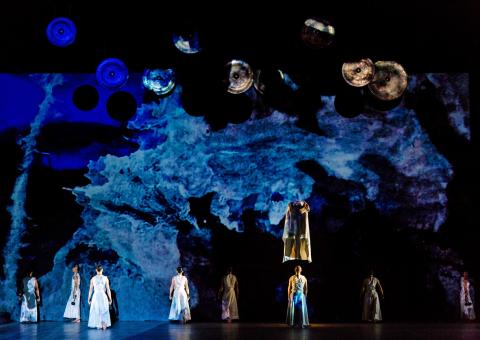
Photo courtesy of Lin Jin-chu
U-Theatre founder and director Liu Ruo-yu (劉若瑀) said the company started working on Dao four years ago, about a year into her self-imposed local hiatus.
While the company continued to fulfill its international obligations during the rest period that she announced in May 2012, it did not mount a major production in Taiwan again until the musical Town of Gold (黃金鄉) in New Taipei City’s Jiufen District (九份) in December 2015, although it did give small shows as part of its traditional long meditative walks around the nation.
COLLABORATIONS
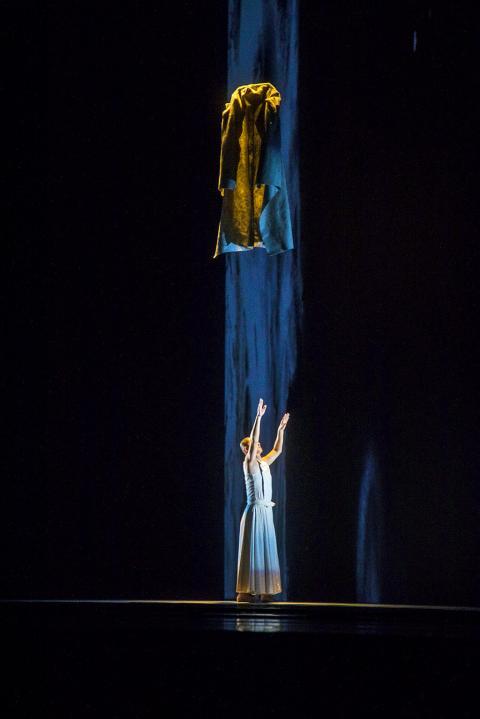
Photo courtesy of Lin Jin-chu
For Dao, Liu reached out to Taipei-born contemporary artist Ko Shu-ling (柯淑玲), also known as Ling Ko, who specializes in abstract ink and five-color watercolor “splash” paintings.
The company has often collaborated with other artists from different genres, ranging from US theater/opera director Robert Wilson for 1433 — The Grand Voyage (鄭和1433) in 2010, to German composer Christian Jost and Rundfunkchor Berlin with 2014’s Lover (愛人), which was performed at the National Theater last year as part of the Taiwan International Festival of Arts.
Although she has been based in Seattle, Washington, for more than three decades, Ko’s paintings have been strongly influenced by her studies of traditional Chinese calligraphy and Buddhist meditation, so working with the very spiritually oriented U-Theatre would seem to be a natural fit.
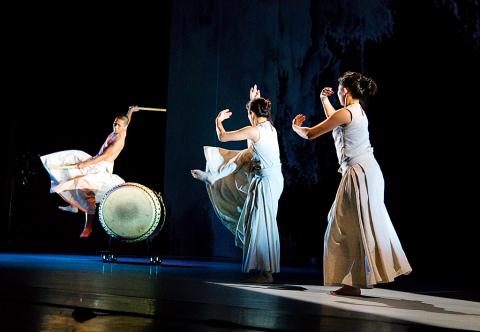
Photo courtesy of Lin Jin-chu
Liu said yesterday she had long been attracted to Ko’s paintings, but did not want to use them as just part of a set or a backdrop.
“You need to feel their energy,” she said.
She said she spent a lot of time discussing how to use Ko’s paintings with multi-media artist Ethan Wang (王奕盛), who helped create some of Cloud Gate Dance Theatre’s (雲門舞集) stunning visuals, including those for Rice (稻禾) and White Water (白水), to form a connection between the artworks and the performers.
Wang ended up using a mix of rear projections, front projections and 3D techniques to make Ko’s paintings feel alive, blowing up the images and slowly moving them across the backdrop, making them appear to be pouring down like waterfalls or moving in the air.
The look is spectacular, but as Liu told reporters yesterday, it did not come cheap.
The troupe’s drumming master, Huang Chih-chun (黃誌群, Adan), said he was inspired by Ko’s paintings when composing the music for the new piece, which features plenty of large gongs.
LAO TZU AND CHUANG TZU
Like many of the company’s previous works, Dao is divided into seven sections. Each section examines a different aspect of the teachings of Lao Tzu (老子) and Chuang Tzu (莊子).
Liu said the first section is about Lao Tzu’s discussion of the shapelessness and emptiness of the universe at the beginning of time; part two is Chuang Tzu’s tale about a giant bird with a wingspan that covers the Earth; part three is from Chuang Tzu’s talk about perception, how we see a creature whose body appears different from ours, with the legs on top, and how we should stop thinking solely in terms of preconceived shapes.
Section four is about Chuang Tzu’s tale of the master butcher who becomes one with the cow he is to kill, so that not only does he perfectly separate the meat from the bones, the cow feels no pain.
Section five is about singing with drums and is a reflection of Chang Tzu’s mediation about his wife’s cycle of life.
Section six, Liu said with a laugh, is a way of turning in a homework assignment she owed to her mentor, Polish director and theater theorist Jerzy Grotowski, from 35 years ago.
Grotowski asked her a question about the Tao Te Ching (道德經) and Chuang Tzu’s butterfly — a tale about how he dreamed of flying like a butterfly, but later could not tell if he was a man dreaming about being a butterfly or a butterfly dreaming about being a man.
She said Grotowski asked her “who is dreaming” and “are you doing your dream?”
Liu said section six is becoming one with nature, about being so quiet that one can feel the trees and other creatures and not be able to separate oneself from them.
She said she asked Adan to study how the butterflies on Laoquanshan (老泉山), where the company is based, to aid him in his own movements.
It is about becoming one with nature, she said, being so quiet that one can feel the trees and other elements.
The final section is a return to the first, the return to a huge eternity, she said.
That section, which was previewed at a photo call yesterday afternoon, features large gongs that float down from the rafters like bubbles — or celestial bodies — as a vibrant painting by Ko is slowly panned across the back of the stage, at times looking like an angry ocean, at others, an infinite cosmos.
The calligraphy for Dao was done by Tong Yang-tze (董陽孜), while the set is by famed Taiwanese lighting and stage designer Lin Keh-hua (林克華), who worked with the company on Lover, Beyond Time and 2009’s The Mountain Dawn (入夜山嵐). Costumes are by fashion designer Fu Tzu-ching ( 傅子菁).
The show runs 70 minutes, with no intermission.
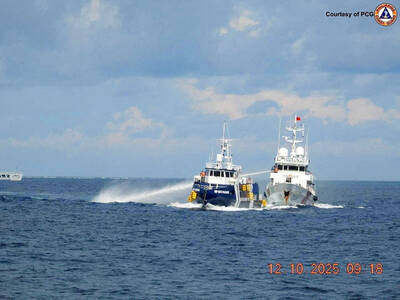
Many people noticed the flood of pro-China propaganda across a number of venues in recent weeks that looks like a coordinated assault on US Taiwan policy. It does look like an effort intended to influence the US before the meeting between US President Donald Trump and Chinese dictator Xi Jinping (習近平) over the weekend. Jennifer Kavanagh’s piece in the New York Times in September appears to be the opening strike of the current campaign. She followed up last week in the Lowy Interpreter, blaming the US for causing the PRC to escalate in the Philippines and Taiwan, saying that as
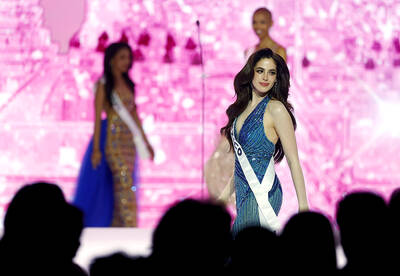
This year’s Miss Universe in Thailand has been marred by ugly drama, with allegations of an insult to a beauty queen’s intellect, a walkout by pageant contestants and a tearful tantrum by the host. More than 120 women from across the world have gathered in Thailand, vying to be crowned Miss Universe in a contest considered one of the “big four” of global beauty pageants. But the runup has been dominated by the off-stage antics of the coiffed contestants and their Thai hosts, escalating into a feminist firestorm drawing the attention of Mexico’s president. On Tuesday, Mexican delegate Fatima Bosch staged a

Taiwan can often feel woefully behind on global trends, from fashion to food, and influences can sometimes feel like the last on the metaphorical bandwagon. In the West, suddenly every burger is being smashed and honey has become “hot” and we’re all drinking orange wine. But it took a good while for a smash burger in Taipei to come across my radar. For the uninitiated, a smash burger is, well, a normal burger patty but smashed flat. Originally, I didn’t understand. Surely the best part of a burger is the thick patty with all the juiciness of the beef, the

Would you eat lab-grown chocolate? I requested a sample from California Cultured, a Sacramento-based company. Its chocolate, not yet commercially available, is made with techniques that have previously been used to synthesize other bioactive products like certain plant-derived pharmaceuticals for commercial sale. A few days later, it arrives. The morsel, barely bigger than a coffee bean, is supposed to be the flavor equivalent of a 70 percent to 80 percent dark chocolate. I tear open its sealed packet and a chocolatey aroma escapes — so far, so good. I pop it in my mouth. Slightly waxy and distinctly bitter, it boasts those bright,